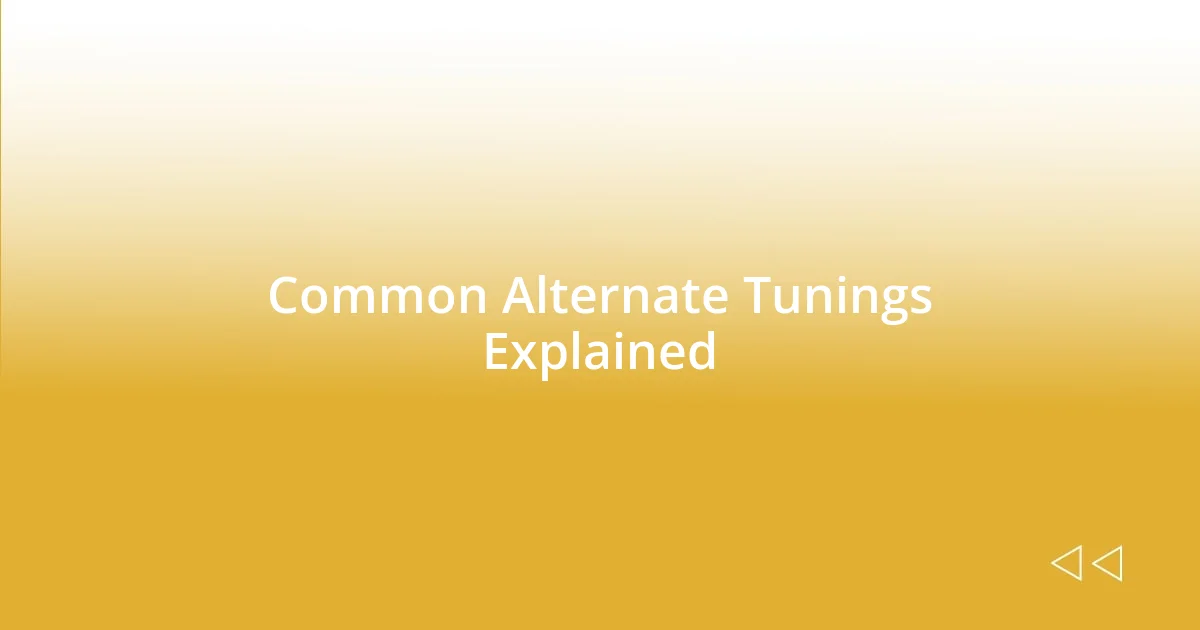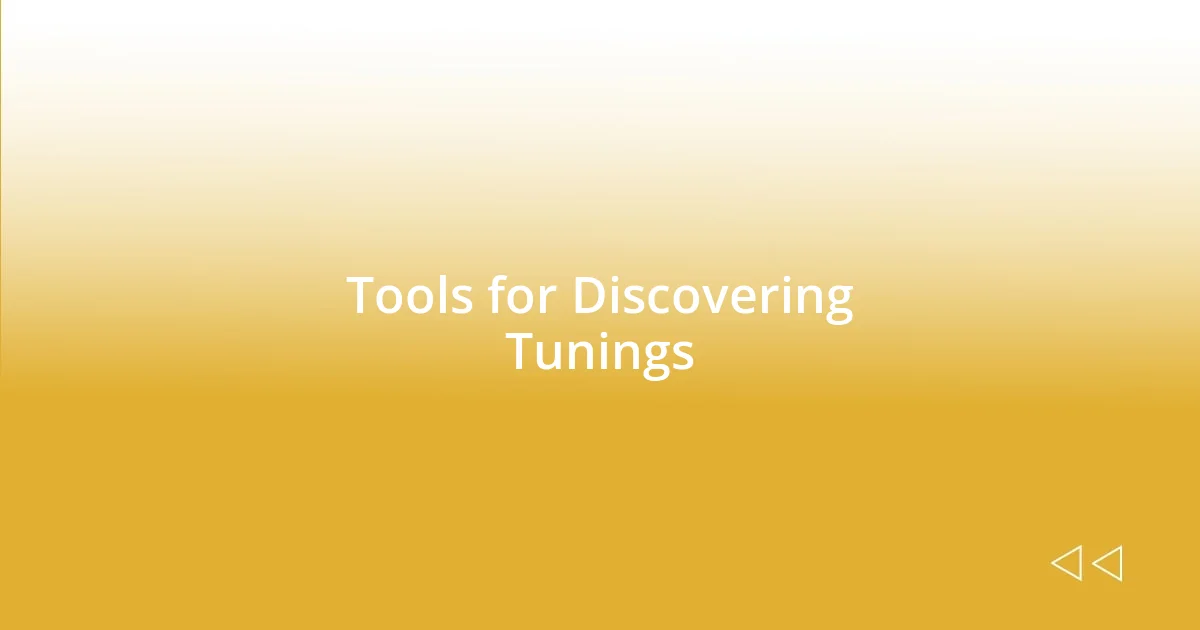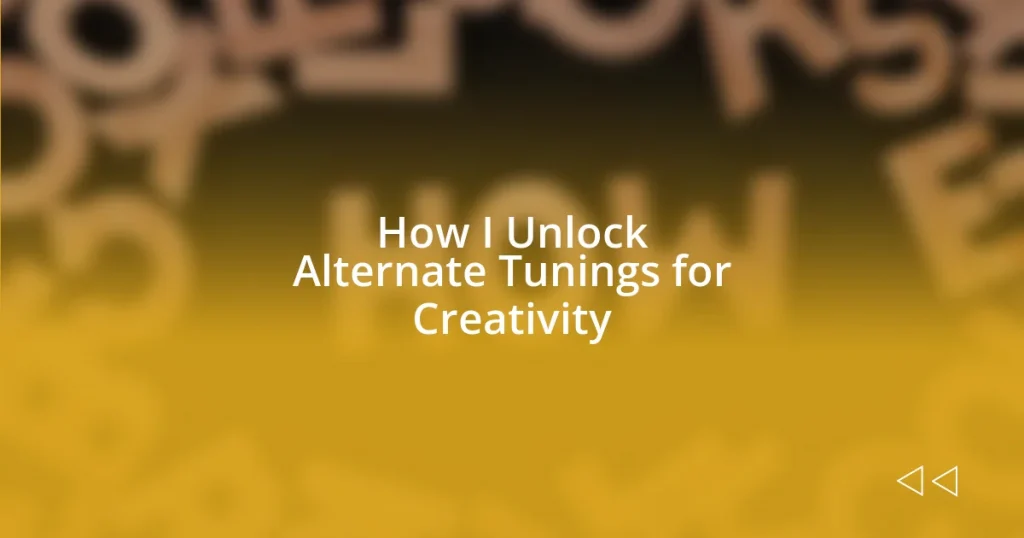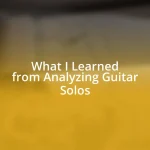Key takeaways:
- Exploring alternate tunings can unlock new emotional landscapes and inspire creativity by offering unique chord voicings and melodies.
- Combining different tunings enhances musical expression, allowing for rich layering of sounds and the creation of evocative atmospheres.
- Utilizing tools like tuning apps, DAWs, and online communities can facilitate the discovery of new tunings and techniques, enriching the creative process.

Understanding Alternate Tunings
I remember the first time I stumbled upon alternate tunings. I was looking for something fresh in my music, feeling stuck in a creative rut with the standard EADGBE. Trying out Open D tuning for the first time was like opening a new door—it was exciting and a bit scary. Do you ever feel that thrill when exploring something new in your art?
Understanding alternate tunings isn’t just about changing the pitch of your strings; it’s about unlocking a new emotional landscape in your music. Each tuning brings a different resonance, allowing for unique chord voicings and melodies that can stir feelings hard to express otherwise. For instance, tuning your guitar to DADGAD creates a rich, ethereal sound that always feels like a new story waiting to be told.
With so many alternate tunings available, how do you choose where to begin? Personally, I find it fascinating to look at the tunings used by my favorite artists. It inspires me to experiment and discover the endless possibilities that lie within my instrument. Each tuning opens a new realm of creativity, making you ask, “What if?” and pushing you to explore further.

Benefits of Alternate Tunings
Exploring alternate tunings can fundamentally shift your creative process. I remember one afternoon tweaking my guitar to C6 tuning, and I was instantly met with a wave of inspiration that I hadn’t felt in years. It’s fascinating how something as simple as a different string arrangement can evoke emotions and ideas I didn’t even know were lurking in the back of my mind.
The benefits of alternate tunings are profound and multifaceted:
- Fresh Soundscapes: Each tuning creates new chord possibilities and harmonic structures that can inspire completely original melodies.
- Enhanced Emotional Expression: Unique tunings often unlock feelings that standard tunings can’t, allowing for deeper emotional storytelling in your music.
- New Playing Techniques: Experimenting with different tunings encourages you to develop novel techniques and fingerings, ultimately broadening your skills as a musician.
- Increased Creativity: The unpredictability of alternate tunings can spark brainstorming sessions, leading you to new song ideas or lyrical themes that feel more aligned with your artistic vision.
- Connection to Artists: Tuning your guitar like a favorite artist opens a personal dialogue with their music, enabling you to channel their spirit while adding your unique touch.
Engaging with these diverse tunings has been a revelation for me—each exploration feels like a musical journey awaiting discovery, which can add layers of depth to your works.

Common Alternate Tunings Explained
Each alternate tuning has its own distinct flavor and characteristics. For example, the Drop D tuning (DADGBE) transforms a standard guitar into a powerful instrument for heavier genres. I first encountered this tuning while jamming with friends, and the heavy, growling chords immediately made my heart race. It felt like I had found a new tool to express my inner energy.
Another interesting tuning is C6, often associated with Hawaiian guitar. I remember trying it out one summer afternoon and feeling transported to a sun-soaked beach, with its bright and cheerful tonality. If you want to evoke nostalgia or create dreamy melodies, C6 might just be the perfect canvas to work with. Each tuning offers not just different notes but a set of emotions waiting to be explored.
Here’s a comparison table of some common alternate tunings and their characteristics:
| Tuning | Characteristics |
|---|---|
| Open D (DADF#AD) | Rich resonance, great for slide guitar and folk melodies |
| Drop D (DADGBE) | Heavy chords, perfect for rock and metal |
| DADGAD | Mystical sound, ideal for fingerstyle and Celtic music |
| C6 (C EGCEGC) | Bright tone, evokes nostalgia, commonly used in Hawaiian music |

Techniques for Experimenting
Experimenting with alternate tunings often starts with a simple change—a half step down here, a drop tuning there. I still remember my first experience with DADGAD tuning. It opened up a new world, and as I played those first chords, I felt a rush of serenity wash over me, almost as if I had stepped into a different reality. What if I told you that a slight adjustment in tuning could lead to an entirely new musical identity?
One technique I find particularly helpful is to focus on familiar songs and recreate them in an alternate tuning. This not only challenges your creativity but also helps you discover new chord voicings that can completely transform the song’s essence. I once reimagined a favorite track in C6 tuning, and the result was astonishing. It became a completely different song that resonated with new emotions. Have you ever stumbled upon a variation that made a familiar piece feel fresh?
Lastly, don’t shy away from improvisation. I often set aside intentional structure, letting my fingers wander across the fretboard, exploring the strings in a freeform manner. During one of those sessions in Open D tuning, I stumbled upon a riff that brought tears to my eyes. It was raw, untouched by conventional ideas, just pure emotion translating into sound. Why not give yourself the freedom to play without boundaries? Embrace the unexpected marvels that unfold in these moments.

Combining Tunings for Unique Sounds
Combining different tunings can lead to captivating musical experiences. I remember sitting down with my guitar, exploring DADGAD while also integrating some elements from Open D. The resulting sound was a complex layer of lightness and depth, almost like painting with sound. Have you ever mixed pieces from different tunings? The sheer joy of discovery can be breathtaking.
I often find that blending tunings helps me step out of my creative comfort zone. One chilly evening, I strummed C6 over chords in Drop D, and the contrast struck a beautiful balance. The warmth of the C6 enhanced the rich, heavy tones of Drop D, creating a unique atmosphere reminiscent of a secret sunset drive. It’s like a musical conversation, where each tuning adds its voice to a larger story.
It’s fascinating how the emotional landscape shifts when you experiment with combining tunings. During a jam session, I once layered the ethereal quality of DADGAD with the buoyant spirit of C6. The music took on an almost cinematic quality, immersing everyone in a wave of nostalgia and adventure. Isn’t it incredible how a few simple changes can evoke such powerful feelings? This kind of exploration can truly unlock new avenues for creativity.

Tools for Discovering Tunings
Tools for discovering alternate tunings can make the creative process an exciting journey. One tool I love to use is an online tuning app; it’s a game-changer. I remember the first time I used it—I had the whole world of tunings at my fingertips. I would input my usual tuning and explore variations with just a click. It felt like a treasure hunt for new sounds!
Another fantastic resource is a digital audio workstation (DAW) that offers chord libraries and instrument simulations. I often find inspiration by dragging a virtual guitar into a project and experimenting with different tunings. Once, I stumbled upon a resonant tone that sparked an entirely new composition. Have you ever found a sound so captivating that it compelled you to keep playing? It’s fascinating how technology can unlock creativity in ways we never imagined.
Lastly, don’t forget about the power of social media and online communities. Platforms like YouTube and various forums can offer a wealth of tunings and techniques shared by fellow musicians. I recall discovering a tutorial series on Open C tuning that completely shifted my approach to songwriting. It was a shared experience—a communal passion for exploration. How often do you engage with your musical community for fresh insights? The connections we build can fuel our musical journeys in profound ways.

Creating Music with Alternate Tunings
When I create music with alternate tunings, it often feels like stepping into a different world altogether. I once ventured into C7 tuning on my acoustic guitar during a rainy afternoon, and the sound that blossomed felt like a warm embrace. Every strum unveiled new melodies, as though the guitar was whispering secrets just waiting to be explored. Have you ever had that feeling where the instrument seems to take you on a journey? It’s delightful.
Setting my guitar to an open E tuning opened up a whole new array of chords and rhythms for me. I stumbled upon it while searching for a sound to express a bittersweet emotion I was experiencing. As I played, the resonance felt almost haunting, yet somehow liberating. The melodies flowed effortlessly; it was as if the music was meant to be unearthed at that precise moment. I find it remarkable how alternate tunings can not only change the sound but also reflect our inner feelings.
One unforgettable evening in a small jam session, I introduced a friend to the wonders of Drop C tuning. His eyes lit up as he realized how powerful a simple change could be. Together, we created a piece that combined intricate fingerpicking with bold power chords. The energy in the room was electric, proving to me that sometimes the best creations come when we embrace the unfamiliar. Have you ever witnessed the spark of creativity igniting in someone else as they discover something new? It’s a reminder that music is a deeply personal and collaborative exploration.















